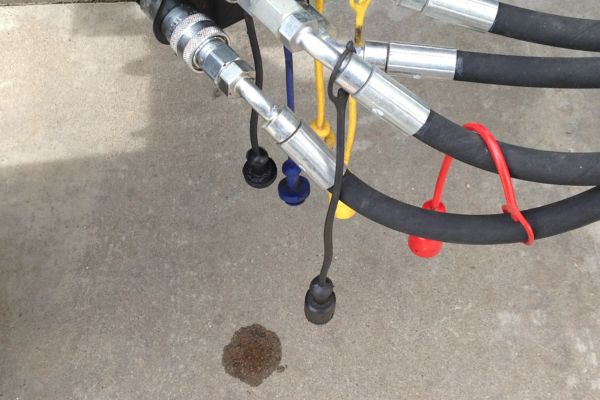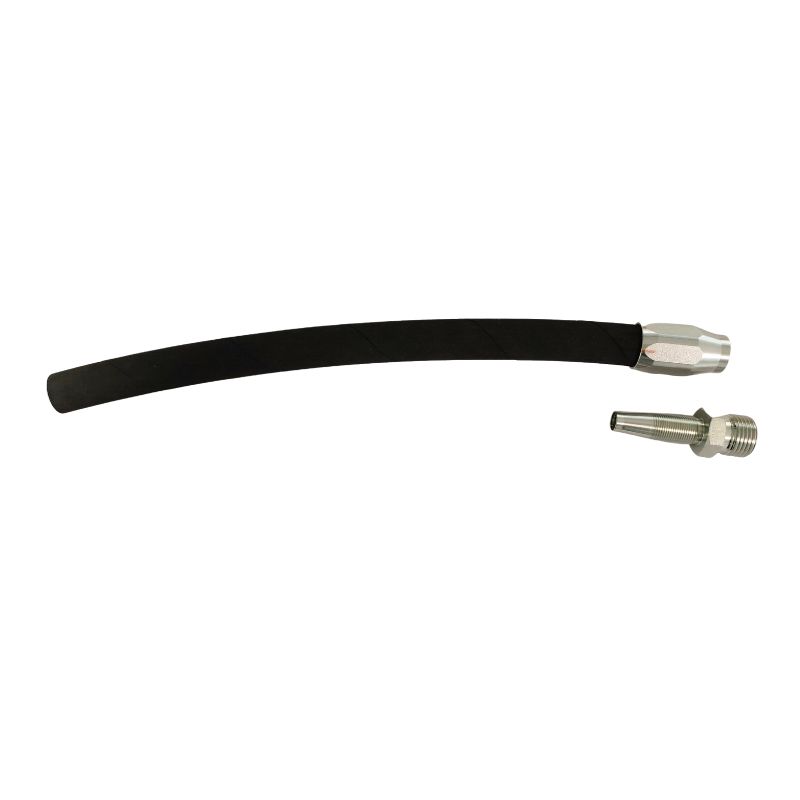Vibration is the invisible enemy of every hydraulic system. On an excavator, constant shock, motion, and pressure changes work together to loosen fittings, damage seals, and create leaks that cause downtime and costly repairs.
The Hostile Environment: An Excavator’s Vibration Profile
An excavator operates in one of the harshest mechanical environments imaginable. Every second of its work cycle generates a mix of vibration, shock, and load reversals that relentlessly attack hydraulic fittings, hoses, and threaded joints. Even perfectly assembled connections are gradually weakened by these forces if not properly secured or supported.

High-Frequency Engine and Pump Vibration
The diesel engine, main hydraulic pumps, and cooling fans produce a continuous stream of high-frequency vibration. Although each movement is microscopic, the frequency is extreme—millions of cycles per hour. Over time, these rapid oscillations cause micro-slippage between threads, gradually reducing the friction that keeps fittings tight.
Low-Frequency Shock from Machine Articulation
Every time the boom, stick, or bucket moves, the entire hydraulic network flexes. These are low-frequency but high-amplitude loads — powerful enough to shift heavy hoses, bend supports, or stress fittings near pivot points.
Likewise, traveling over rocky or uneven terrain sends shockwaves through the frame and into the hydraulic circuit, multiplying stress at each connection.
Combined Forces: The Perfect Storm
Neither vibration nor shock alone is as destructive as their combined effect. High-frequency vibration acts like a lubricant, “dithering” threads and lowering static friction. Then, when a low-frequency shock arrives, it provides the mechanical energy to turn the loosened fitting fractionally—repeated thousands of times.
The result is a progressive loosening process that goes unnoticed until the system begins to leak under pressure. Without proper countermeasures—such as lockwire, thread locking compounds (where appropriate), and vibration-isolating clamps—this cycle repeats indefinitely.
| Interaction Type | Mechanism | Result |
| High-frequency + low amplitude | Thread fretting | Loss of preload |
| Low-frequency + high amplitude | Shock torque | Fitting back-off |
| Combined (real condition) | Micro-slip + rotation | Gradual leak and joint failure |
The Physics of Loosening: The Battle for Preload
A properly tightened hydraulic fitting doesn’t stay secure by chance—it depends on a precise mechanical principle known as preload. This clamping force is what keeps sealing faces locked together and prevents movement under pressure. Vibration’s ultimate goal is to erode that preload, one microscopic slip at a time, until the fitting loosens and the seal fails.
What Is Preload? The Essential Clamping Force
When you tighten a fitting or bolt, the male threads are slightly stretched while the female threads are compressed, acting together like a miniature spring system. The stored energy from this deformation becomes preload—a continuous force pressing the mating surfaces together.
This preload serves two vital purposes:
- It creates clamping pressure between sealing faces.
- It generates thread friction, resisting any rotational movement.
Without sufficient preload, even the most precisely machined threads will vibrate loose.
| Parameter | Description | Typical Value Range |
| Thread stretch | Elastic elongation of bolt/fitting | 0.02–0.1 mm |
| Clamping force (preload) | Force holding sealing faces | 60–90% of yield strength |
| Friction contribution | Resistance preventing rotation | 85–90% of applied torque converts to friction |
How Vibration Attacks the Threads
Vibration introduces transverse motion—tiny side-to-side forces acting perpendicular to the preload direction. Each vibration cycle temporarily overcomes the static friction between threads. When that happens, the fitting moves slightly in the loosening direction before friction re-engages.
This process repeats thousands of times per minute, slowly reducing the stored spring tension in the threads. The more vibration, the faster the friction barrier is destroyed.
Key Effects of Vibration:
- Micro-slips between thread flanks
- Progressive loss of clamping force
- Surface fretting and wear at contact points
- Eventual thread back-off and seal failure
| Vibration Type | Effect on Threads | Resulting Damage |
| High-frequency (engine/pump) | Repeated micro-slip | Fretting corrosion |
| Low-frequency (boom shock) | Axial load variation | Loss of preload |
| Combined | Friction loss + rotation | Progressive loosening |
Installation Errors: Inviting Vibration to Win
A perfectly designed fitting can be made vulnerable to vibration by simple, common installation mistakes. These errors fail to establish the proper initial preload, giving vibration an easy and immediate advantage.
The Critical Sin of Under-Tightening
This is the number one cause of vibration-induced loosening. If the fitting isn’t tightened to the manufacturer’s specification, it never achieves full preload. The clamping force is too low from the start, and the threads have insufficient friction to resist vibration.

The Damage of Over-Tightening
Overtightening is just as bad. It can yield (permanently stretch) the threads or crush the sealing surfaces (like the flare on a JIC fitting). This damaged component can no longer maintain a consistent clamping force and will quickly loosen.
Using Damaged or Low-Quality Components
Fittings with galled threads, worn sealing faces, or those made from inferior materials will never hold torque reliably. The damaged surfaces create stress risers and areas where preload cannot be evenly applied, making them highly susceptible to vibration.
| Installation Variable | Correct Procedure (Resists Vibration) | Incorrect Procedure (Vulnerable to Vibration) |
| Torque Application | Use a calibrated torque wrench or the “Flats From Wrench Resistance” method to achieve correct preload. | Guessing the torque by “feel.” Using cheater bars or impact wrenches, which leads to gross over-tightening. |
| Component Quality | Use only high-quality, undamaged fittings from reputable manufacturers that meet SAE/ISO standards. | Re-using fittings with damaged threads, scored sealing faces, or visible corrosion. Using cheap, unbranded fittings. |
| Thread Engagement | Ensure the fitting is threading in smoothly with at least 4-5 full turns of thread engagement before tightening. | Forcing a cross-threaded fitting or using a fitting with insufficient thread engagement to properly stretch and clamp. |
| Seal Condition | Always use a new, correct-size and material O-ring or seal for every connection. | Re-using old, flattened O-rings or using seals that are visibly nicked, cut, or hardened. |
Strategic Defense: How to Defeat Vibration
Vibration on an excavator can never be eliminated—but it can be controlled. The key is not to fight the vibration itself, but to protect your hydraulic connections from its effects. Correct hose routing, proper clamping, and vibration-resistant fittings work together as a system to preserve preload, prevent loosening, and extend service life.
The Power of Proper Clamping
An unsecured hose behaves like a whip. Every pulse, jolt, or shock is transmitted directly into the fitting, repeatedly loading and unloading the connection. Over time, this constant movement fatigues the metal and breaks down the seal.
Using vibration-dampening clamps with rubber or polymer inserts isolates the hose from structural vibration and absorbs energy before it reaches the fitting. Correctly placed clamps can reduce vibration transfer by more than 70%.
| Clamp Type | Material | Typical Use |
| Standard P-clamp | Rubber-lined steel | General hydraulic routing |
| Twin line clamp | Aluminum with elastomer insert | Parallel hoses |
| Heavy-duty block clamp | Polypropylene or PA | Excavator arms and booms |
| Soft-jawed clamp | Urethane or nylon liner | Paint-sensitive or stainless fittings |
Installation Tips:
- Always place clamps close to fittings to relieve bending stress.
- Maintain consistent spacing—generally every 1 meter for long runs.
- Avoid over-tightening clamp bolts, which can crush the hose cover.

Respect Hose Routing and Movement
Routing is not guesswork—it’s engineering. Hoses must move freely with the excavator’s articulation without being stretched, twisted, or kinked. When a hose is too short, it exerts tensile stress on the fitting every time the boom or arm moves. When too long, it whips and rubs, accelerating cover wear and vibration fatigue.
Best Practices for Routing:
- Follow the natural motion path of the machine’s articulation.
- Provide enough slack for full extension without tension.
- Avoid tight bends and maintain the minimum bend radius.
- Use clamps, guides, and sleeves to prevent contact with metal edges.
- Keep hoses away from heat sources and sharp surfaces.
| Routing Error | Effect on Hose Life | Result |
| Too short | Constant tension | Fitting loosening and leaks |
| Too long | Hose whipping and abrasion | Outer cover wear |
| Sharp bend near fitting | Localized stress | Premature burst |
| Poor alignment | Twisting under motion | Structural fatigue |
Choosing the Right Fitting for the Job
Not all fittings handle vibration equally. Older designs like tapered pipe threads (NPT/BSPT) rely on thread interference for sealing—making them especially vulnerable to loosening under vibration. Modern hydraulic systems increasingly use O-Ring Face Seal (ORFS) or 37° flare (JIC) fittings, where sealing occurs on precision-machined surfaces rather than the threads.
Advanced Solutions and The Role of Maintenance
For the most extreme, hard-to-solve vibration issues, advanced solutions can be employed. However, a consistent and detail-oriented maintenance routine remains the most effective long-term defense.
When to Use Liquid Threadlockers
In areas of extreme vibration where fittings repeatedly loosen despite proper torque, a medium-strength, oil-tolerant threadlocker can be used. It fills the microscopic gaps in the threads, preventing the transverse slip that allows loosening.
The Importance of Regular Torque Checks
On critical connections, especially after a new hose has been installed or major work performed, it is good practice to re-check the torque of fittings after a few hours of operation as the components settle.
Vibration as a Diagnostic Tool
If a specific fitting loosens repeatedly, it can be a symptom of another problem. Look for a failing pump, a bad motor bearing, or another component that is generating an abnormal amount of vibration and transmitting it down that hydraulic line.
| Problem Scenario | Primary Cause | First-Line Solution | Advanced Solution |
| Fitting loosens after a few days on a newly installed hose. | Insufficient Preload. The fitting was likely under-torqued during initial installation. | Disconnect, inspect, and re-torque the fitting to the correct specification using a torque wrench. | After re-torquing, mark the nut and body with a paint line (“witness mark”) to visually check for future rotation. |
| The same fitting on the hammer circuit loosens every month. | Extreme Shock & Vibration. The application environment is exceeding the fitting’s ability to hold torque. | Ensure the hose is properly clamped with vibration-dampening clamps. Verify routing has adequate slack. | Use a high-vibration resistant fitting (like ORFS). Apply a medium-strength liquid threadlocker during assembly. |
| A case drain line fitting on a swing motor keeps leaking. | Abnormal System Vibration. The component itself may be failing and generating excess vibration. | Check the torque and integrity of the fitting. | Mount an accelerometer on the motor to check for vibration levels that are out of spec, indicating a potential bearing failure. |
| A fitting that was previously reliable starts to leak. | Component Fatigue. The fitting’s threads or sealing faces may have become worn or damaged over time. | Disassemble and meticulously inspect the threads and sealing surfaces of both male and female ends for damage. | Replace both mating halves of the connection with new, high-quality components. |
A leak-free hydraulic system isn’t just about strong hydraulic fittings—it’s about precision, discipline, and smart design. Vibration can’t be stopped, but it can be controlled with proper torque, high-quality components, correct clamping, and regular inspection.
FAQ
Is it a good idea to just tighten a leaking fitting a little bit more?
No. This is a common mistake. The leak is a symptom that the fitting has lost its preload. Simply tightening it more without inspection can lead to over-torquing and damage. You should loosen, inspect the seal and threads, then re-torque to the proper specification.
Will using two wrenches stop vibration from loosening a fitting?
Using two wrenches is essential during installation to prevent twisting the hose, but it does not prevent loosening from in-service vibration. Proper preload (torque) and clamping are what resist vibration.
Are some types of fittings better than others for high-vibration areas?
Yes. Fittings with a “soft seal,” like O-Ring Face Seal (ORFS) or O-Ring Boss (ORB), are generally superior in high-vibration environments because the seal is more resilient and independent of the clamping force from the threads.
Can I use Teflon tape to help secure a fitting against vibration?
Absolutely not. Teflon tape should never be used on modern hydraulic fittings like JIC or ORFS. It acts as a lubricant, which can actually reduce the friction needed to hold torque, and it is a major source of system contamination when it shreds.
How tight is “tight enough” to prevent loosening?
“Tight enough” is a precise value, not a feeling. You must use a torque wrench set to the manufacturer’s specification for that fitting’s size and type. If a torque wrench is unavailable, the “Flats From Wrench Resistance” (FFWR) method is the next best option.
Why is clamping the hose so important?
An unclamped hose allows the machine’s vibration to transfer directly to the fitting, concentrating the destructive force where it can do the most damage. A proper clamp absorbs and dampens this energy before it can attack the threaded connection.





